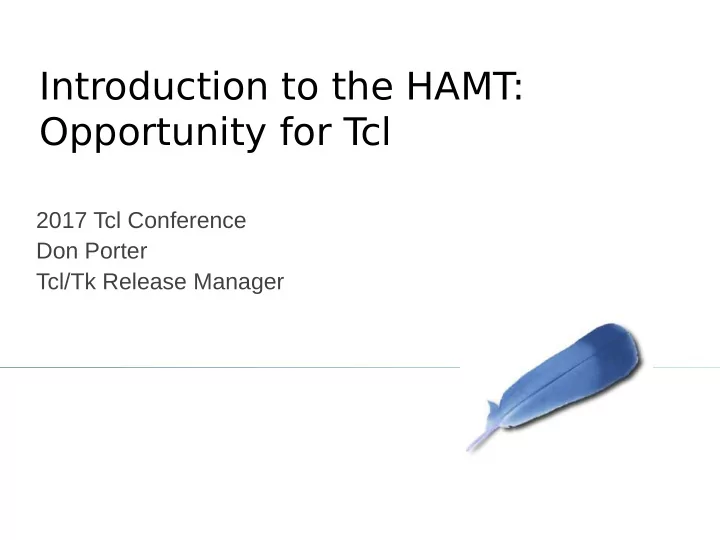

Introduction to the HAMT: Opportunity for T cl 2017 Tcl Conference Don Porter Tcl/Tk Release Manager
Hash Maps in Tcl ● Dictionaries ● Array variables ● Name lookups (commands, vars, etc.) ● Much much more… – Most make use of Tcl_HashTable. ● Customizable
Hash Map – Giant Bucket Array ● Define Hash: Key → index – Efficient – Range evenly distributed over indices Search bucket [ Hash(key) ] for key 2 64 0 …..
Hash Map – Tcl_HashTable Search bucket [ Hash(key) & mask ] for key 2 3 0
Hash Map – Hash Trie Follow Hash( key ) path to leaf storing key 1 0 …..
Hash Map – Hash Trie Eliminate empty buckets and paths 1 0 …..
Hash Map – Hash Trie Store hashes – shorten paths w/o branches 1 0
Hash Map – Hash Trie Store node IDs – shorten paths w/o branches 1 0
Hash Array-Map Trie (HAMT) Structure nodes as array maps 0011 0110 1100 1100
Array Map Encoding ● Two bits encoding bucket leaf children – Bit n is set → child n is a bucket ● Hash and leaf pointer are stored in array ● Two bits encoding subnode children – Bit n is set → child n is a subnode ● Pointer to subnode is stored in array
Removal Operation 1 0 …..
Removal Operation – Tcl_HashTable (Destructive) 2 3 2 3 0 0 →
Removal Operation – HAMT (non-destructive) OLD 0011 0110 1100 1100 0110 NEW
IMMUTABILITY ● Values as Read-only structures ● Matches value semantics of Tcl ● Alternative to Copy on Write – CoW is a discipline to implement immutable values out of mutable foundations
...on Steroids ● Presented as binary tree – Two two-bit encoding maps per node – Easy to draw and explain – Inessential ● Implemented as 64-ary tree – Two 64-bit encoding maps per node – Shallow, wide trees → few hops in lookup – Depth of 11 covers entire 16 exbibyte capacity
Demo: dict vs hamt % set data [lmap _ [lrepeat 20000 {}] tcl::mathfunc::rand] % set d [dict create {*}$data] % time {foreach {k v} $data {set d [dict remove $d $k]}} -> 23839420 microseconds per iteration % set h [hamt create {*}$data] % time {foreach {k v} $data {set h [hamt remove $h $k]}} -> 77113 microseconds per iteration % set d [dict create {*}$data] % time {foreach {k v} $data {dict unset d $k}} -> 28610 microseconds per iteration
The Enemy
Merge Demo % time {set d [dict merge $d1 $d2]} → 681783 microseconds per iteration % time {dict merge $d $d} → 1032838 microseconds per iteration % time {dict merge $d $d1} → 927085 microseconds per iteration % time {set h [hamt merge $h1 $h2]} → 294936 microseconds per iteration % time {hamt merge $h $h} → 65 microseconds per iteration % time {hamt merge $h $h1} → 218641 microseconds per iteration
More dict vs hamt ● For one hashmap, hamt uses more memory. ● For set of related hashmaps, will use less. ● Operation speeds are competitive. (oom) ● Avoids copy catastrophe by design ● Still prototype quality – Known improvement avenues ● Immutability benefits...
Immutable Hashmap Benefits ● Read-only values share easily – Think “threads” ● Keep useful checkpoints – Think built-in command set of an interp. ● Controlled teardowns – Think namespace delete ● Caching and Epochs – No epoch for something that does not change ● Scaling?
How can I try it? ● Branch dgp-refactor in the Tcl fossil repository. – https://core.tcl.tk/tcl ● [hamt info] reports interesting details. ● Comments welcome.
Relaxed Radix Balance (RRB) Tree ● HAMT : Hashmap :: RRB : Sequence – Think “list” – Think “string” (list of characters) ● Foundation of the Clojure Vector ● Stay Tuned!
Conclusions ● Protoype HAMT implementation underway – Basic functions complete. ● Initial testing shows promise – Not yet a clear failure. ● Immutable structures are useful tools. ● Other immutable structure opportunities. ● Further work is needed.
Recommend
More recommend